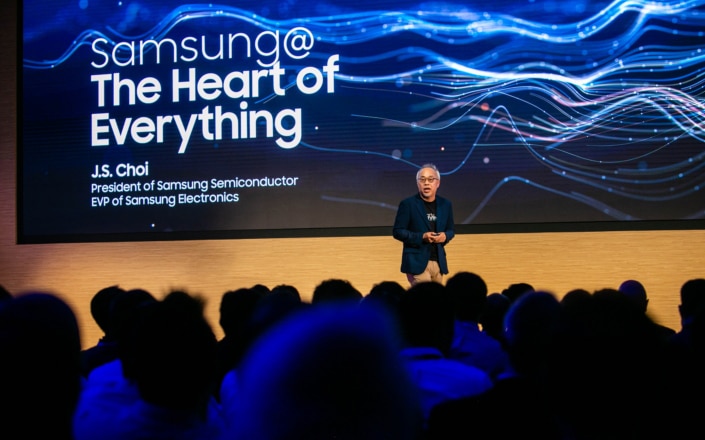
Samsung announced today at their annual Tech Day event the release of its next generations of NAND SSD and DRAM memory technologies. Additionally, Samsung Foundry announced it has begun production of EUV-based 7nm LLP process, claiming to provide up to a 40% increase in area efficiency with 20% higher performance or 50% lower power consumption, resulting in better yields with fewer layers.

The following were unveiled at Samsung Tech Day:
- 7nm EUV process node – Released by Samsung’s Foundry Business, the 7nm EUV process node aims to significant increases in power, performance, and area, enabling application improvements such as 5G, Artificial Intelligence, Enterprise and Hyperscale Datacenter, IoT, Automotive, and Networking.
- SmartSSD– a field programmable gate array (FPGA) SSD that offers accelerated data processing and the ability to bypass server CPU limits.
- QLC-SSD– An SSD designed for enterprise and datacenters, offering 33-percent more storage per cell than TLC-SSD, consolidating storage footprints and improving total cost of ownership (TCO)
- 256-gigabyte 3DS (3-dimentional stacking) RDIMM (registered dual in-line memory module) – Based on the 10nm-class 16-gigabit DDR4 DRAM that will lower power consumption and improve performance by doubling its current maximum capacity.
The 7LPP EUV process technology provides great advancement in semiconductor fabrication, including a maximum of 40 percent area reduction, up to 50 percent dynamic power reduction, and a performance increase of up to 20 percent compared to the 10nm processes.
Through products such as the new SmartSSD, QLC-SSD, 256GB 3DS RDIMM and High Bandwidth Memory 2 Aquabolt, Samsung enables the most advanced providers of server-less computing. There products aim to allow datacenter operations to scale quicker while saving costs by accelerating data processing, bypassing server CPU limits and reducing power demands.
Also included in Samsung’s flash memory products are Key Value (KV)-SSD and Z-SSD. KV-SSD will increase efficiency in block storage while reducing latency and allowing datacenter performance to scale evenly when CPU architectures max out. On the other hand, the Z-SSD, with dual port high availability, low latency, and a U.2 form factor, aims to be at the top of the leaderboard when it comes to flash memory speed. The Z-SSD will also feature a PCIe Gen 4 interface with a 12GB/s sequential read.
The Tech Day AI display highlighted transfer speeds of 16Gb GDDR6 (64GB/s), low latency of the Z-SSD, and performance of Aquabolt, the highest DRAM-based memory solution currently available on the market. These solutions aim to enable Samsung’s enterprise and datacenter client’s new opportunities in application learning.
D1Y 8Gb DDR4 Server DRAM was also one of the enterprise products on display at Tech Day. This product incorporates a more advanced DRAM process which results in lower power consumption. Additionally, Samsung’s 256GB 3DS RDIMM helps improve performance and enable memory-intensive servers capable of up to 16TB.
In addition to this, Samsung is offering 10GB/s performance via its dual-ort x4 PCIe Gen 4 32TB SSD. Samsung’s KV-SSD enables server performance to scale even as CPU architectures max out, providing write amplification factor (WAF) improvements and scalability while bringing a competitive TCO. Lastly, the 1Tb QLC-SSD, when compared to hard disk drives, presents an advanced storage option for enterprise clients.
Samsung’s QLC-SSD, Z-SSD, and 8GB Aquabolt enable high-performance computing customers overcome performance barriers. The 8GB is quoted to have a total of 307GB/s per HBM cube, which would make it an incredibly fast and one of the highest performance DRAM-based memory solutions available. Both QLC-SSD and Z-SSD are also offered in a tiered storage solution, resulting in a quoted 53-percent increase in system performance.
Samsung’s SmartSSD increase efficiency and speed, effectively lowering operating costs. The new SmartSSD will overcome latency and energy consumption issues by incorporating an FPGA accelerator into the SSD unit, allowing for faster data processing through bypassing server CPU limits. SmartSSDs will then have higher processing and scalable performance, better dedupe and compression, more VMs, improved time-to-insight, and fewer CPUs per system.
Samsung states that they will continue to innovate and raise the bar for semiconductor technologies, as it has shown it will through their sixth-generation V-NAND built on a single structure, or with ‘1-stack technology,’ and a sub-10nm DRAM with EUB for super-high density and performance, claiming to pave the way for 3nm by 2020.
Sign up for the StorageReview newsletter
